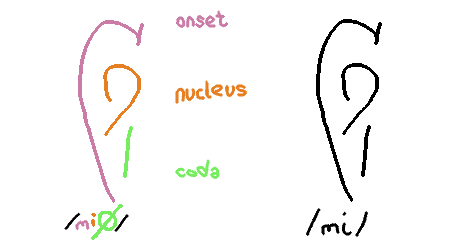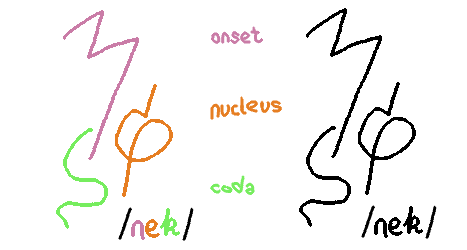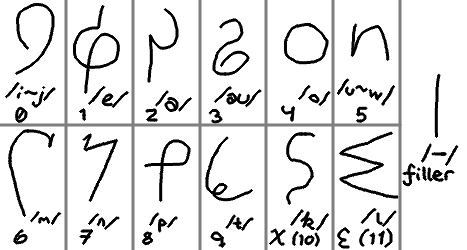Yama-pali-auk: Difference between revisions
(added wiki links) |
|||
| (13 intermediate revisions by the same user not shown) | |||
| Line 1: | Line 1: | ||
page is under construction!! | page is under construction!! info will be missing!! | ||
welcome to the page for yama-pali-auk! this language was created by me, katherine "kaw57" awesome, on 2023 dec 20 at 19:24 utc-6:00 and is actively being worked on by me to this day. i don't remember why i originally created it, but i am currently planning to use it as either the common tongue in my conworld or the ancestor to all the catwoman languages. more about them at some point in the future, maybe. keep your eyes peeled! <br> | welcome to the page for yama-pali-auk! this [https://en.wikipedia.org/wiki/Constructed_language language was created] by me, katherine "kaw57" awesome, on 2023 dec 20 at 19:24 utc-6:00 and is actively being worked on by me to this day. i don't remember why i originally created it, but i am currently planning to use it as either the common tongue in my conworld or the ancestor to all the catwoman languages. more about them at some point in the future, maybe. keep your eyes peeled! <br> | ||
== phonology/orthography == | == phonology/orthography == | ||
yama-pali-auk has 6 consonants, 4 vowels, and 2 consovowels. for simplicity's sake, i will put all of the phonemes in one table. | === [https://en.wikipedia.org/wiki/Phonology phonology] & [https://en.wikipedia.org/wiki/Romanization romanization] === | ||
yama-pali-auk has 6 consonants, 4 vowels, and 2 [https://en.wikipedia.org/wiki/Semivowel consovowels]. for simplicity's sake, i will put all of the phonemes in one table. | |||
{| class="wikitable" | {| class="wikitable" | ||
|+ phonology | |+ phonology | ||
|- | |- | ||
! !! labial !! coronal !! back | ! !! [https://en.wikipedia.org/wiki/Labial_consonant labial] !! [https://en.wikipedia.org/wiki/Coronal_consonant coronal] !! [https://en.wikipedia.org/wiki/Dorsal_consonant back] | ||
|- | |- | ||
| sonorant || m || n || l | | [https://en.wikipedia.org/wiki/Sonorant sonorant] || [https://en.wikipedia.org/wiki/Voiced_bilabial_nasal m] || [https://en.wikipedia.org/wiki/Voiced_dental,_alveolar_and_postalveolar_nasals n] || [https://en.wikipedia.org/wiki/Voiced_dental,_alveolar_and_postalveolar_lateral_approximants l] | ||
|- | |- | ||
| obstruent || p || t || k | | [https://en.wikipedia.org/wiki/Obstruent obstruent] || [https://en.wikipedia.org/wiki/Voiceless_bilabial_plosive p] || [https://en.wikipedia.org/wiki/Voiceless_dental_and_alveolar_plosives t] || [https://en.wikipedia.org/wiki/Voiceless_velar_plosive k] | ||
|- | |- | ||
| consovowel || || i~j || u~w | | consovowel || || [https://en.wikipedia.org/wiki/Close_front_unrounded_vowel i]~[https://en.wikipedia.org/wiki/Voiced_palatal_approximant j] || [https://en.wikipedia.org/wiki/Close_back_rounded_vowel u]~[https://en.wikipedia.org/wiki/Voiced_labial%E2%80%93velar_approximant w] | ||
|- | |- | ||
| mid || || e || o | | [https://en.wikipedia.org/wiki/Mid_vowel mid] || || [https://en.wikipedia.org/wiki/Close-mid_front_unrounded_vowel e] || [https://en.wikipedia.org/wiki/Close-mid_back_rounded_vowel o] | ||
|- | |- | ||
| low || || a || au | | [https://en.wikipedia.org/wiki/Open_vowel low] || || [https://en.wikipedia.org/wiki/Open_front_unrounded_vowel a] || au | ||
|} | |} | ||
the consovowels are treated as consonants in the onset and vowels in the nucleus, and should be treated as such. of course, as an imperfect human, there is great variation in how i pronounce these phonemes. i have designed the allophony to account for this. <br> | the consovowels are treated as consonants in the [https://en.wikipedia.org/wiki/Syllable#Onset onset] and vowels in the [https://en.wikipedia.org/wiki/Syllable#Nucleus nucleus], and should be treated as such. of course, as an imperfect human, there is great variation in how i pronounce these phonemes. i have designed the [https://en.wikipedia.org/wiki/Allophone allophony] to account for this. <br> | ||
/n/ can be rendered as [ŋ] preceding /k/ ; /l/ is often [ɫ] ; /p/, /t/, and /k/ are usually fricated in the coda position, becoming [f], [s~θ], and [x~h~ç] respectively ; /i/ may also be [ɪ] at times ; /u/ may be [ʊ], and /w/ may be [v~ʋ] ; /e/ is often [ɛ] ; /o/ can be [ɔ] ; /a/ is likely the most explicitly varied vowel here, with a range of [ɑ~æ~ɐ~ə] ; and /au/ is actually [au̯~aʊ̯]. there is doubtlessly a lot more allophony going on than i've documented, but i'm not a professional and separately don't enjoy listening to clips of my voice repeatedly to figure out exactly what sound i'm producing. <br> | /n/ can be rendered as [[https://en.wikipedia.org/wiki/Voiced_velar_nasal ŋ]] preceding /k/ ; /l/ is often [[https://en.wikipedia.org/wiki/Voiced_dental,_alveolar_and_postalveolar_lateral_approximants#Velarized_alveolar_lateral_approximant ɫ]] ; /p/, /t/, and /k/ are usually fricated in the coda position, becoming [[https://en.wikipedia.org/wiki/Voiceless_labiodental_fricative f]], [[https://en.wikipedia.org/wiki/Voiceless_alveolar_fricative s]~[https://en.wikipedia.org/wiki/Voiceless_dental_fricative θ]], and [[https://en.wikipedia.org/wiki/Voiceless_velar_fricative x]~[https://en.wikipedia.org/wiki/Voiceless_glottal_fricative h]~[https://en.wikipedia.org/wiki/Voiceless_palatal_fricative ç]] respectively ; /i/ may also be [[https://en.wikipedia.org/wiki/Near-close_near-front_unrounded_vowel ɪ]] at times ; /u/ may be [[https://en.wikipedia.org/wiki/Near-close_near-back_rounded_vowel ʊ]], and /w/ may be [[https://en.wikipedia.org/wiki/Voiced_labiodental_fricative v]~[https://en.wikipedia.org/wiki/Voiced_labiodental_approximant ʋ]] ; /e/ is often [[https://en.wikipedia.org/wiki/Open-mid_front_unrounded_vowel ɛ]] ; /o/ can be [[https://en.wikipedia.org/wiki/Open-mid_back_rounded_vowel ɔ]] ; /a/ is likely the most explicitly varied vowel here, with a range of [[https://en.wikipedia.org/wiki/Open_back_unrounded_vowel ɑ]~[https://en.wikipedia.org/wiki/Near-open_front_unrounded_vowel æ]~[https://en.wikipedia.org/wiki/Near-open_central_vowel ɐ]~[https://en.wikipedia.org/wiki/Mid_central_vowel ə]] ; and /au/ is actually [au̯~aʊ̯]. there is doubtlessly a lot more allophony going on than i've documented, but i'm not a professional and separately don't enjoy listening to clips of my voice repeatedly to figure out exactly what sound i'm producing. <br> | ||
most phonemes are romanized as their | most phonemes are romanized as their [https://en.wikipedia.org/wiki/International_Phonetic_Alphabet IPA] representation. /i~j/ and /u~w/ can be represented as ⟨ i / j / y ⟩ and ⟨ u / w / v ⟩ respectively and in free variation. <br> | ||
yama-pali-auk also has a script. that will be covered in its own | yama-pali-auk also has a script. that will be covered in the next section. | ||
== punctuation == | |||
=== writing === | |||
as mentioned earlier, yama-pali-auk has its own script. these images describe the basics. <br> | |||
[[File:Y-p-a size diff filler and end.png|thumb|alt=A depiction of the size difference between the filler character and the end of sentence marker in yama-pali-auk. |size difference between the filler character and the end of sentence marker]] | |||
[[File:Y-p-a script.png|none|alt=The yama-pali-auk script, and a brief summary what each of the characters can mean. |the script]] | |||
[[File:Y-p-a_syll_stack_demo_a.png|alt=A demonstration and explanation of syllable stacking in yama-pali-auk. |demonstration of syllable stacking using the first person singular pronoun, «mi»]] | |||
[[File:Y-p-a_syll_stack_demo_b.png|alt=A secondary demonstration of syllable stacking in yama-pali-auk. |another demonstration of syllable stacking using «nek», a word with a vibe of time or monodirectionality]] <br> | |||
when not being used as numbers, the symbols stack together in syllables. blank positions are filled using the filler character. when the filler character is alone, it marks the start of a name, similar to a capital letter. unlike capital letters, this ''only'' occurs at the start of names. <br> | |||
[[File:Y-p-a name demo.png|alt=A demonstration of the null character being used to mark the name "Katherine" in a sentence. The sentence translates to something like, "Katherine is my name."|using the filler character to mark a name, using my name (katherine) as an example.]] | |||
<br> | |||
if the nucleus of a syllable uses the filler character, it is likely being used as a [https://en.wikipedia.org/wiki/Variable_(mathematics) mathematical variable]. that's actually a legacy feature from back when i kept a journal for my random thoughts. now i can share them with other people so this feature is obsolete, but cool. however, a fully blank syllable is used as a general [https://en.wikipedia.org/wiki/Profanity "bad word"]. think your fucks or shits. it, by definition, cannot be romanized or pronounced, but it can be written, which the language is meant to be. | |||
<br> | |||
a fun cosmetic feature is that you can write in any direction you want, provided you mirror/rotate the glyphs accordingly and indicate a change in direction with an arrow. if no arrow is present, assume the previous line's reading direction. if there is no arrow or previous line, assume left-to-right. <br> | |||
[[File:Y-p-a omnidirectional writing.png|alt=An image showcasing omnidirectional writing in yama-pali-auk.|what omnidirectional writing could look like in practice]] | |||
== grammar == | |||
yama-pali-auk has mostly [https://en.wikipedia.org/wiki/Word_order#Pragmatic_word_order free word order], the only requirement being that the [https://en.wikipedia.org/wiki/Subject_(grammar) subject] is somewhere before the [https://en.wikipedia.org/wiki/Object_(grammar) object]. this is due to the lack of a subject or object marker. the verb, however, is clear, as it is marked for [https://en.wikipedia.org/wiki/Grammatical_tense tense]. <br> | |||
=== affixes === | |||
{| class="wikitable" | |||
|+ nouns | |||
|- | |||
! [https://en.wikipedia.org/wiki/Grammatical_number#Singular_and_plural singular] !! [https://en.wikipedia.org/wiki/Grammatical_number#Singular_and_plural plural] | |||
|- | |||
| -i || -au | |||
|} | |||
{| class="wikitable" | |||
|+ verbs | |||
|- | |||
! [https://en.wikipedia.org/wiki/Past_tense past] !! [https://en.wikipedia.org/wiki/Present_tense present] !! [https://en.wikipedia.org/wiki/Future_tense future] | |||
|- | |||
| -et || -ik || -ip | |||
|} | |||
{| class="wikitable" | |||
|+ misc. | |||
|- | |||
! [https://en.wikipedia.org/wiki/Affirmation_and_negation#Negation negation] | |||
|- | |||
| -el | |||
|} | |||
when applying a suffix to a word that ends in a vowel, the original vowel is overwritten by the suffix's vowel. also, the two [https://en.wikipedia.org/wiki/Copula_(linguistics) copulae] (tek and muk, "to be" and "to be at" respectively) have the ''k'' removed. <br> | |||
''-el'' may be applied before or after any other suffixes, depending on what feels right for what you wish to say. | |||
{| class="wikitable" | |||
|+ pronouns | |||
|- | |||
! !! singular !! plural | |||
|- | |||
| [https://en.wikipedia.org/wiki/Grammatical_person first person] || mi || mau | |||
|- | |||
| [https://en.wikipedia.org/wiki/Grammatical_person second person] || ti || tau | |||
|- | |||
| [https://en.wikipedia.org/wiki/Grammatical_person third person] || wi || wau | |||
|} | |||
technically, you could analyze the pronouns as just single letters taking the noun suffixes. however, it would not make sense to apply the verb suffixes to ''m-'', ''t-'', or ''w-'', especially because of how ''tek'' and ''muk'' take their suffixes. | |||
=== punctuation === | |||
this part is why i don't like using the romanization. some of the common characters are hard to type, and it looks bad with the latin script. | this part is why i don't like using the romanization. some of the common characters are hard to type, and it looks bad with the latin script. | ||
{| class="wikitable" | {| class="wikitable" | ||
| Line 34: | Line 89: | ||
| · || end of word; space || " || mid-quote space | | · || end of word; space || " || mid-quote space | ||
|- | |- | ||
| > || end of clause || ‿ || mid-clarification space | | > || end of [https://en.wikipedia.org/wiki/Clause clause] || ‿ || mid-clarification space | ||
|- | |- | ||
| | || end of sentence || , || mid-list space | | | || end of sentence || , || mid-list space | ||
| Line 42: | Line 97: | ||
| ⸮ || end of joke || = || second-order compound | | ⸮ || end of joke || = || second-order compound | ||
|- | |- | ||
| ! || end of ecstatic statement || etc. || theoretically, this list is infinite | | ! || end of [https://en.wikipedia.org/wiki/Exclamation_mark ecstatic statement] || etc. || theoretically, this list is infinite | ||
|} | |} | ||
higher-order compounds are formed by stacking more dashes on top of each other. | higher-order compounds are formed by stacking more dashes on top of each other. compounds are explained in their own subsection. when writing, «⸮» is given a stroke to differentiate it from «?». | ||
== | === compounds === | ||
[to be continued in future edits] | |||
Latest revision as of 08:50, 11 August 2024
page is under construction!! info will be missing!!
welcome to the page for yama-pali-auk! this language was created by me, katherine "kaw57" awesome, on 2023 dec 20 at 19:24 utc-6:00 and is actively being worked on by me to this day. i don't remember why i originally created it, but i am currently planning to use it as either the common tongue in my conworld or the ancestor to all the catwoman languages. more about them at some point in the future, maybe. keep your eyes peeled!
phonology/orthography
phonology & romanization
yama-pali-auk has 6 consonants, 4 vowels, and 2 consovowels. for simplicity's sake, i will put all of the phonemes in one table.
| labial | coronal | back | |
|---|---|---|---|
| sonorant | m | n | l |
| obstruent | p | t | k |
| consovowel | i~j | u~w | |
| mid | e | o | |
| low | a | au |
the consovowels are treated as consonants in the onset and vowels in the nucleus, and should be treated as such. of course, as an imperfect human, there is great variation in how i pronounce these phonemes. i have designed the allophony to account for this.
/n/ can be rendered as [ŋ] preceding /k/ ; /l/ is often [ɫ] ; /p/, /t/, and /k/ are usually fricated in the coda position, becoming [f], [s~θ], and [x~h~ç] respectively ; /i/ may also be [ɪ] at times ; /u/ may be [ʊ], and /w/ may be [v~ʋ] ; /e/ is often [ɛ] ; /o/ can be [ɔ] ; /a/ is likely the most explicitly varied vowel here, with a range of [ɑ~æ~ɐ~ə] ; and /au/ is actually [au̯~aʊ̯]. there is doubtlessly a lot more allophony going on than i've documented, but i'm not a professional and separately don't enjoy listening to clips of my voice repeatedly to figure out exactly what sound i'm producing.
most phonemes are romanized as their IPA representation. /i~j/ and /u~w/ can be represented as ⟨ i / j / y ⟩ and ⟨ u / w / v ⟩ respectively and in free variation.
yama-pali-auk also has a script. that will be covered in the next section.
writing
as mentioned earlier, yama-pali-auk has its own script. these images describe the basics.


when not being used as numbers, the symbols stack together in syllables. blank positions are filled using the filler character. when the filler character is alone, it marks the start of a name, similar to a capital letter. unlike capital letters, this only occurs at the start of names.

if the nucleus of a syllable uses the filler character, it is likely being used as a mathematical variable. that's actually a legacy feature from back when i kept a journal for my random thoughts. now i can share them with other people so this feature is obsolete, but cool. however, a fully blank syllable is used as a general "bad word". think your fucks or shits. it, by definition, cannot be romanized or pronounced, but it can be written, which the language is meant to be.
a fun cosmetic feature is that you can write in any direction you want, provided you mirror/rotate the glyphs accordingly and indicate a change in direction with an arrow. if no arrow is present, assume the previous line's reading direction. if there is no arrow or previous line, assume left-to-right.

grammar
yama-pali-auk has mostly free word order, the only requirement being that the subject is somewhere before the object. this is due to the lack of a subject or object marker. the verb, however, is clear, as it is marked for tense.
affixes
| singular | plural |
|---|---|
| -i | -au |
| past | present | future |
|---|---|---|
| -et | -ik | -ip |
| negation |
|---|
| -el |
when applying a suffix to a word that ends in a vowel, the original vowel is overwritten by the suffix's vowel. also, the two copulae (tek and muk, "to be" and "to be at" respectively) have the k removed.
-el may be applied before or after any other suffixes, depending on what feels right for what you wish to say.
| singular | plural | |
|---|---|---|
| first person | mi | mau |
| second person | ti | tau |
| third person | wi | wau |
technically, you could analyze the pronouns as just single letters taking the noun suffixes. however, it would not make sense to apply the verb suffixes to m-, t-, or w-, especially because of how tek and muk take their suffixes.
punctuation
this part is why i don't like using the romanization. some of the common characters are hard to type, and it looks bad with the latin script.
| symbol | meaning | symbol | meaning |
|---|---|---|---|
| ⁎ | start of paragraph | : | start of quote / clarification / list |
| · | end of word; space | " | mid-quote space |
| > | end of clause | ‿ | mid-clarification space |
| | | end of sentence | , | mid-list space |
| ? | end of question | - | first-order compound |
| ⸮ | end of joke | = | second-order compound |
| ! | end of ecstatic statement | etc. | theoretically, this list is infinite |
higher-order compounds are formed by stacking more dashes on top of each other. compounds are explained in their own subsection. when writing, «⸮» is given a stroke to differentiate it from «?».
compounds
[to be continued in future edits]

